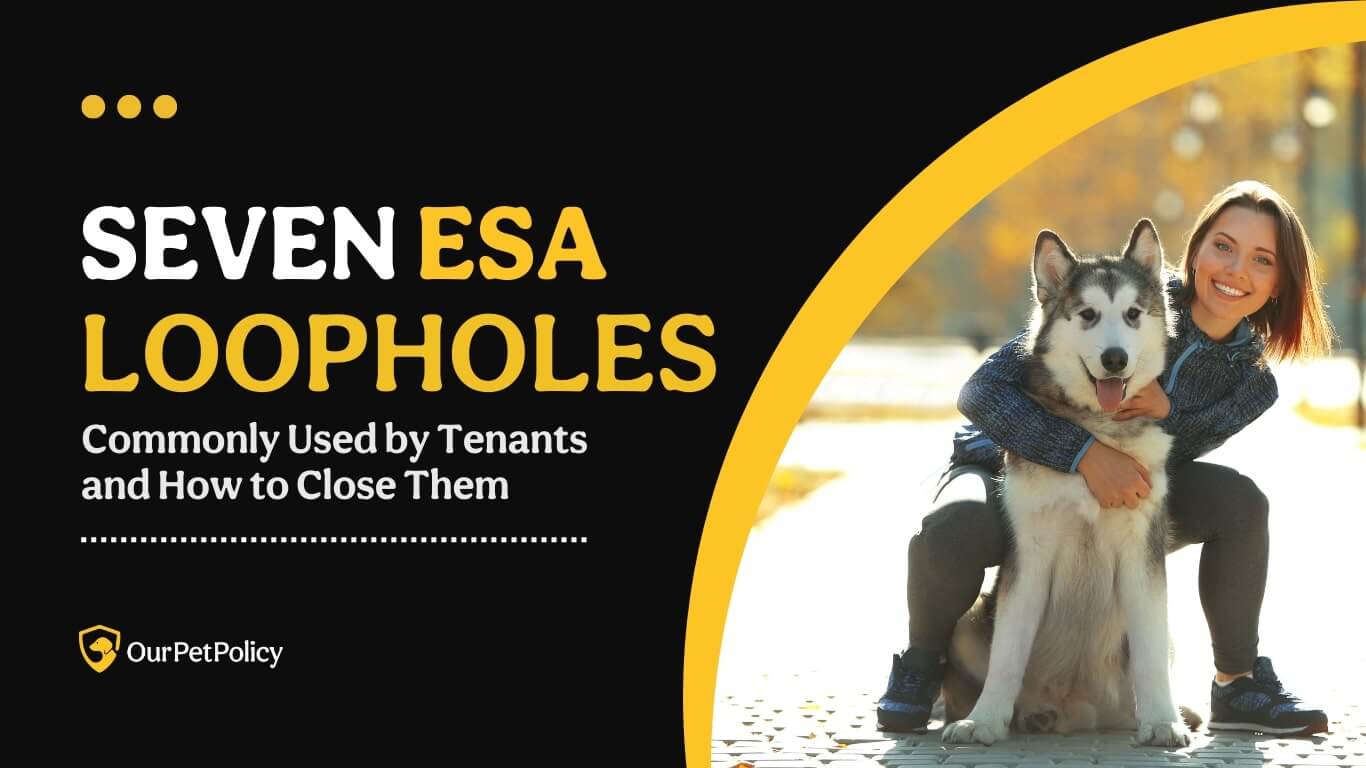With the surge in popularity of emotional support animals (ESAs) in recent years, landlords and property owners have reported a corresponding increase in unfavorable behavior on the part of tenants. Residential pet owners can often find crafty ways to skirt around policies or stretch the rules of leases and pet agreements in order to avoid fees or bring more animals into their homes.
Here are seven of the most common loopholes that tenants often use in regards to ESAs and how you, as a landlord or property manager, can close them for good.

1. Taking Advantage of No-Unauthorized-Pet Fees
Although pets may be allowed at your property, such animals should always be authorized and approved under the terms of a lease. If unauthorized pets are found to be on premises, penalties should be issued. Otherwise, tenants can find ways to hide the animals as long as they can avoid paying any specified deposits or fees.
All leases for pet-owning residences should adequately define what constitutes an authorized pet and what associated fees are charged should an unauthorized animal be brought home. Ideally, such a penalty would have the effect of dissuading tenants from breaking the lease terms in the first place.
2. Claiming ESA When Caught With an Unauthorized Pet
Even if you have a no-pets policy in place at your property, it’s still important for the lease to outline any associated fees or penalties if unauthorized animals are discovered. Otherwise, tenants can use this loophole to hide the animal until they are caught and then claim it’s an emotional support animal.
In addition, the lease terms should specify all requirements to appropriately document and verify claims of emotional support animals as soon as the pet is acquired. This will prevent any claims from occurring later on in an effort to avoid mandatory documentation.
3. Using ESAs to Get Around Breed Restrictions
Breed restrictions are often a good idea to avoid large or potentially aggressive dog breeds from taking over common areas and causing disruptions with residents and other animals. However, these restrictions cannot be applied to emotional support animals per federal law.
Regulations do dictate, however, that even emotional support animals can be banned from a residential property based on a history of misbehavior. If pets are permitted at your property, the lease terms and/or ESA policies should specify how and when ESAs may be barred from the premises.

4. Avoiding Household Restrictions on Pet Limits
If pets are permitted at your property, limits should always be specified as to how many animals may live within a single unit or residence. Even with these limits in place, however, tenants can still use ESA policies as a loophole to add more animals above any established limits.
For example, if there’s a maximum of two animals permitted, tenants can claim that the third pet living with them is an ESA. This is why it’s crucial that all ESAs be adequately vetted and verified to ensure tenants are not fraudulently housing more than the maximum number of permitted animals.
5. Using Multiple Therapists for Multiple ESAs
Obtaining a true emotional support animal starts with seeing a doctor or specialized mental health therapist. Upon evaluating the patient’s specific circumstances, the clinician will write a letter recommending the animal. Rarely will ESA letters be written for more than one or two pets by the same health professional.
In order to house more pets beyond what’s recommended, tenants have been known to see multiple therapists in order to obtain additional emotional support animals. As a landlord or property manager, you’ll want to be sure that any such letters are verified and in compliance with local and federal laws.

6. Pet Waste Fees That Are Too Low
Pet waste is a common problem for many landlords and property owners. In formulating any pet policy for your residences, pet waste fees should be used as means of deterrence to avoid soiling floors and furniture throughout the property. When setting fees, the amounts chosen can make a significant impact in encouraging or discouraging unfavorable behavior.
If the fee is only $5 per violation, for example, tenants would likely see that as too low to warrant training their dog to eliminate where it is allowed. Animal mapping tools can help to track pets across your properties and identify violations. Cameras can also be helpful in certain locations to obtain proof of which pet caused the waste incident so that adequate fees can be charged accordingly.
7. Claiming a Pet is Visiting to Avoid Fees/Deposits
Some properties may permit visiting pets to reside for a limited period of time in a residence. If this is allowed, your pet policy should detail explicit guidelines around how long a pet can visit and how they should be documented once they enter the property.
If you don’t have an application for visiting pets, tenants can simply claim that their pet is visiting whenever you see them with the animal. Some may use this as a loophole to avoid paying any deposits or fees associated with housing the animal in their residence full-time.
Close the Loopholes with OurPetPolicy
Landlord Tech specializes in providing digital tools to help property owners and managers successfully manage pets in their properties. Our OurPetPolicy platform provides an integrated solution that helps to identify fraudulent ESAs, convert them into paying pet charges, collect pet fees, reduce animal-related damage, and develop policies that help you ensure tenants are compliant with all applicable laws and regulations.
Contact us today for a free demonstration to see how OurPetPolicy can help you better manage your residential pet program.

